| Mercury
Transit of Face of Sun (7.5.2003) !!!New!!! Mercury exit sequence and
animation.
During Mercury transit I
captured 3.5GBytes data. It will take me some time to
process all data.
Here are actual results:
Note about time measurement:
An hour before observation I adjusted my
clocks according to TV teletext time (rather high
precision) with error less than 0.5 second. In the
observing place I adjusted computer time according to my
clocks. The time of AVI frames was calculated according
to file's date-time (it shows only even seconds).
Estimated precision is about ±1 second, maximum ±2seconds.
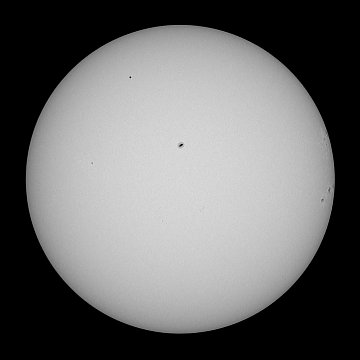
Click the
image tosee picture with higher resolution (3.00"/pixel).
You can also look at high resolution image 1024x1024
pixels (2.00"/pixel) here. |
7.5.2003, 09:50:30 (07:50:30
UT)
Resolution: 6.00
arcsec/pixel
Camera: Nikon Coolpix
995, f=29.7mm
Telescope: 80mm F5
Refractor, 25mm eyepiece afocal
Filter: Baader
AstroSolar™ foil sun filter
Result focal length: 475.2mm (~58X Zoom)
Result focal ratio: F5.94
Exposure: 4x 1/1000s (ISO100, auto white balance)
Camera control: The
Force software
Processed by K3CCDTools,
then in Corel PhotoPaint.
|
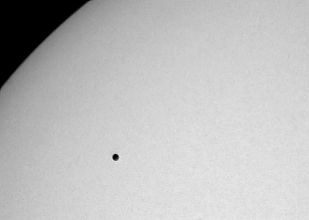
Click the
image tosee picture with higher resolution (0.96"/pixel). |
7.5.2003, 09:05:14 (07:05:14
UT)
Resolution: 1.92 arcsec/pixel
Camera: Vesta 675SC2 with Barlow 3X, IRB
filter
Telescope: 80mm F5
Refractor
Filter: Baader
AstroSolar™ foil sun filter
Result focal length: 1200mm
Result focal ratio: F15
Exposure: 22x 1/125s (auto white balance)
Processed by K3CCDTools,
then in Corel PhotoPaint. |
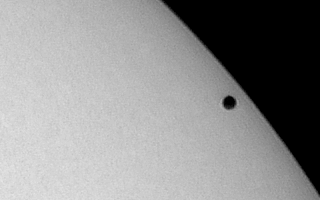
Mercury exit animation (40s interval between
frames)You
can see higher resolution animation and browse
through it frame by frame by using K3's Astro Video Player -
click the relevant icon:
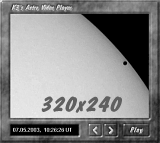
1.44"/pixel, 194kB |
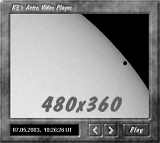
0.96"/pixel, 476kB |
Be patient,
please, while sequence is loaded.
|
Exit of Mercury, 7.5.2003,
12:24:26-12:31:46 (10:24:26-10:31:46)
Resolution: 0.96 arcsec/pixel
Camera: Vesta 675SC2 with Barlow 3X, IRB
filter
Telescope: 80mm F5
Refractor
Filter: Baader
AstroSolar™ foil sun filter
Result focal length: 1200mm
Result focal ratio: F15
Exposure: series of ~22x 1/125s (auto white
balance)
Processed by K3CCDTools,
then in Corel PhotoPaint.
Seeing: strong windThe animation on the left
side shows the exit stage of Mercury during 7 min
and 20 sec. Unfortunately, the strong wind
destroyed many frames in AVI (blurred because of
rapid movement).
The frames for animation were created from 1.15GB
AVI by stacking about 22 frames series. The whole
AVI was divided to sections with length of 50
frames per section (i.e. 10s interval). From each
section the best 20-25 frames were stacked. All
frames were aligned manually in K3CCDTools (no
available program was able to align them
automatically, because of movement of Mercury).
Stacking was done in X2 mode (for better result
resolution).
Then K3CCDTools were used for extracting G-channel
from frames (the new feature of K3CCDTools, not
present in current public release). G-channel is
significantly sharper than grayscale image (remember,
I used cheap achromatic refractor).
Result frames were loaded again in K3CCDTools and
aligned for animation. Then they were exported to
AVI file (still in X2 mode with resolution 960x720
pixels).
AVI file was processed in VirtualDUB program (used
bicubic resize filter + unsharp mask 3, 15, 0).
As VirtualDUB generates only 24-bit not
compressed AVIs, the result AVI files were
converted to grayscale by means of K3CCDTools.
The animation on the left side shows frames in
interval of 40s (reduced size). The speed is
about 100x faster than real speed.
Click the K3's Astro
Video Player icons to see higher
resolution animation with interval of 20s.
|
Exit sequence near T3
contact
 Here is contact
prediction table for my observation place (time
is UT):
| T1 |
T2 |
T3 |
T4 |
| 05:11:38 |
05:16:04 |
10:27:47 |
10:32:11 |
In the above sequence picture the T3 contact
is visible at 10:27:46UT.
|
Here are some photos of our expedition.
Most of them took my wife Susan. The photos were taken in
time when camera was not attached to telescope :-)
In this place I would like to thank to my friend Lubos,
who borrowed me his car (blue Seat).

[06:31] My friend Kamil and me are preparing our
equipment |
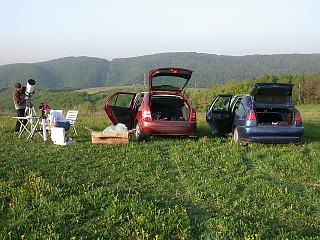
[06:32] Overall look to our observing post |
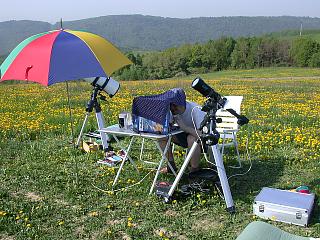
[09:04] Focusing in open field was really hard
task. The notebook screen was not visible on
direct sun light. |
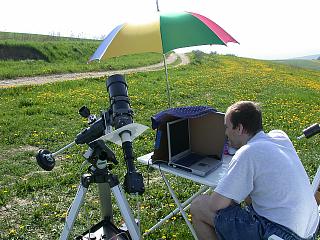
[09:05] Detailed view of observing post |
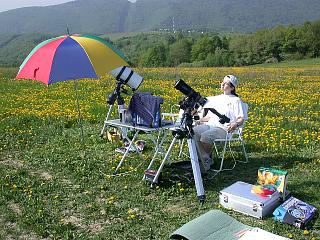
[09:12] My wife Susan also appreciated Sun "observation"
with closed eyes ;-) |
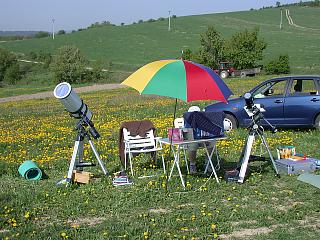
[09:12] Our equipment - Kamil's 8" F4 GS
Optical Newtonian and my 80mm F5 refractor |
Back to
Solar System Page
Computer generated images,
real images, drawings and texts are property of the
author and may not be reproduced or used without
permission of author.

Last Update:
20.5.2003
|